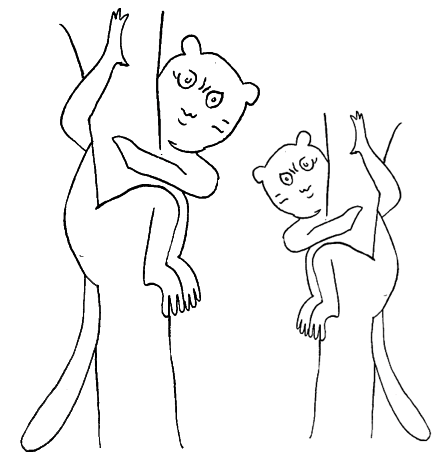
民族浄化
Ethnic cleansing

☆ 民族浄化とは、社会を民族的に均質化することを目的として、特定の地域から民族、人種、宗教的集団を組織的に強制的に排除することである。強制送還や集団 移住といった直接的な排除方法に加え、殺害、強姦、財産の破壊といった手段で被害集団に逃亡を迫り、その帰還を妨げることで強制移住を促す間接的な方法も 含まれる。民族浄化に関する定義や罪状についてはしばしば議論が巻き起こる。一部の研究者は強制同化や 特定の集団の地域から人口を減少させる手段として、強制的な同化や大量虐殺を含める研究者もいれば、含めない研究者もいる。 どの出来事が民族浄化に当たるかについては学者の間で意見が一致していないが、歴史上多くの事例が発生しており、この用語は1990年代のユーゴスラビア紛争で、大量虐殺行為を婉曲的に表現するために加害者によって初めて使用された。 それ以来、ジャーナリズムによりこの用語は広く受け入れられるようになった。当初の研究は、民族浄化事件を説明するものとして根深い敵意に焦点を当ててい たが、最近の研究では民族浄化は「国家の同質化傾向の自然な延長」として描かれており、安全保障上の懸念や民主化の効果を強調し、民族間の緊張を要因の一 つとして描いている。研究はまた、民族浄化を引き起こす要因または助長要因としての戦争の役割にも焦点を当てている。しかし、同じような戦略的状況にある 国家でも、安全保障上の脅威とみなされる少数民族に対する政策は大きく異なる場合がある。 民族浄化は国際刑事法では法的定義がないが、その実行方法は人道に対する罪と見なされ、ジェノサイド条約にも該当する可能性がある。
★ There is no ethnic cleanising without poetry - Slaboj Zizek.
| Ethnic cleansing is
the systematic forced removal of ethnic, racial, or religious groups
from a given area, with the intent of making the society ethnically
homogeneous. Along with direct removal such as deportation or
population transfer, it also includes indirect methods aimed at forced
migration by coercing the victim group to flee and preventing its
return, such as murder, rape, and property destruction.[1][2][3][4][5]
Both the definition and charge of ethnic cleansing is often disputed,
with some researchers including and others excluding coercive
assimilation or mass killings as a means of depopulating an area of a
particular group.[6][7][8] Although scholars do not agree on which events constitute ethnic cleansing,[7] many instances have occurred throughout history; the term was first used during the Yugoslav Wars in the 1990s by the perpetrators as a euphemism for genocidal practices. Since then, the term has gained widespread acceptance due to journalism.[9] Although research originally focused on deep-rooted animosities as an explanation for ethnic cleansing events, more recent studies depict ethnic cleansing as "a natural extension of the homogenizing tendencies of nation states" or emphasize security concerns and the effects of democratization, portraying ethnic tensions as a contributing factor. Research has also focused on the role of war as a causative or potentiating factor in ethnic cleansing. However, states in a similar strategic situation can have widely varying policies towards minority ethnic groups perceived as a security threat.[10] Ethnic cleansing has no legal definition under international criminal law, but the methods by which it is carried out are considered crimes against humanity and may also fall under the Genocide Convention.[1][11][12] 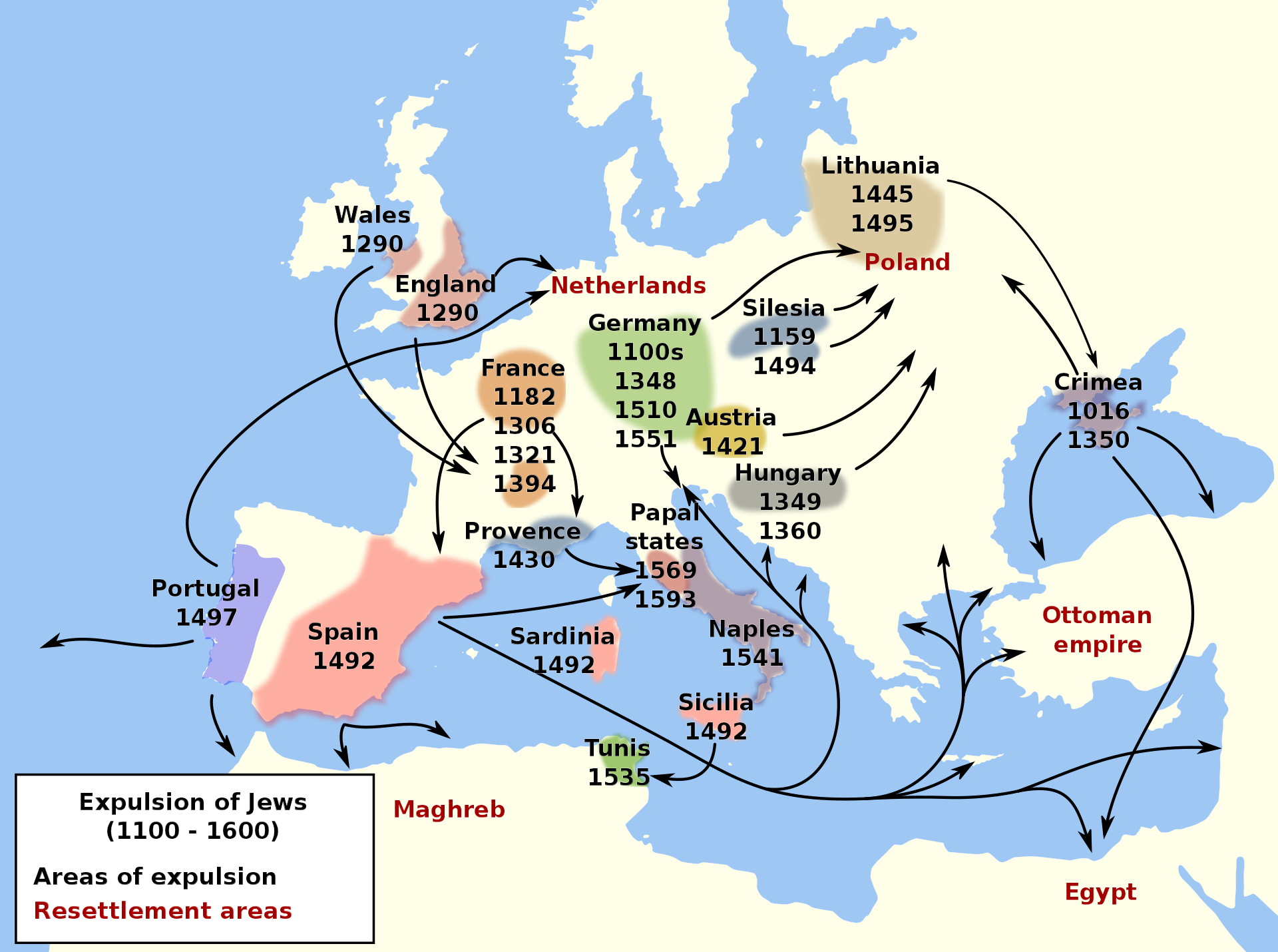 Expulsions of Jews in Europe from 1100 to 1600 |
民族浄化とは、社会を民族的に均質化することを目的として、特定の地域
から民族、人種、宗教的集団を組織的に強制的に排除することである。強制送還や集団移住といった直接的な排除方法に加え、殺害、強姦、財産の破壊といった
手段で被害集団に逃亡を迫り、その帰還を妨げることで強制移住を促す間接的な方法も含まれる[1][2][3][4][5]。民族浄化に関する定義や罪状
についてはしばしば議論が巻き起こる。一部の研究者は強制同化や
特定の集団の地域から人口を減少させる手段として、強制的な同化や大量虐殺を含める研究者もいれば、含めない研究者もいる[6][7][8]。 どの出来事が民族浄化に当たるかについては学者の間で意見が一致していないが[7]、歴史上多くの事例が発生しており、この用語は1990年代のユーゴス ラビア紛争で、大量虐殺行為を婉曲的に表現するために加害者によって初めて使用された。それ以来、ジャーナリズムによりこの用語は広く受け入れられるよう になった[9]。当初の研究は、民族浄化事件を説明するものとして根深い敵意に焦点を当てていたが、最近の研究では民族浄化は「国家の同質化傾向の自然な 延長」として描かれており、安全保障上の懸念や民主化の効果を強調し、民族間の緊張を要因の一つとして描いている。研究はまた、民族浄化を引き起こす要因 または助長要因としての戦争の役割にも焦点を当てている。しかし、同じような戦略的状況にある国家でも、安全保障上の脅威とみなされる少数民族に対する政 策は大きく異なる場合がある[10]。 民族浄化は国際刑事法では法的定義がないが、その実行方法は人道に対する罪と見なされ、ジェノサイド条約にも該当する可能性がある[1][11] [12]。  ヨーロッパ内におけるユダヤ人排斥(追放) |
Etymology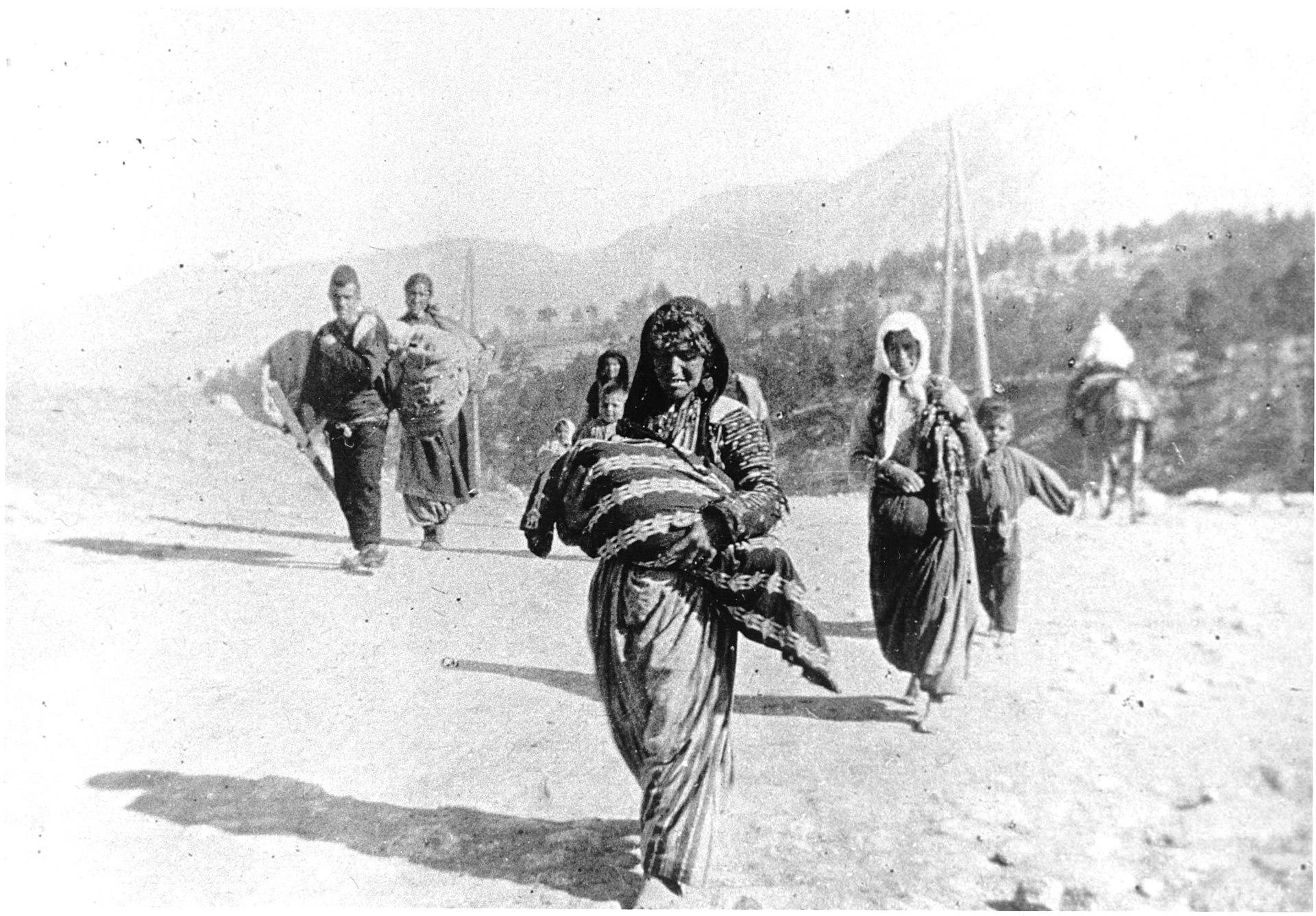 Refugees at Taurus Pass during the Armenian genocide. The Young Turk triumvirate aimed to reduce the number of Armenians to below 5–10% of the population in any part of the Ottoman empire, which resulted in the elimination of a million Armenians.[13] An antecedent to the term is the Greek word andrapodismos (ἀνδραποδισμός; lit. "enslavement"), which was used in ancient texts. e.g., to describe atrocities that accompanied Alexander the Great's conquest of Thebes in 335 BCE.[14] The expulsion of the Moriscos from Spain between 1609 and 1614 is considered by some authors to be one of the first episodes of state-sponsored ethnic cleansing in the modern western world.[15] Raphael Lemkin, who coined the term "genocide", considered the displacement of Native Americans by American settlers as a historical example of genocide.[16] Others, like historian Gary Anderson, contend that genocide does not accurately characterize any aspect of American history, suggesting instead that ethnic cleansing is a more appropriate term.[17] Circassian genocide, also known as "Tsitsekun", is often regarded by various historians as the first large-scale ethnic cleansing campaign launched by a state during the 19th century industrial era.[18][19] Imperial Russian general Nikolay Yevdakimov, who supervised the operations of Circassian genocide during 1860s, dehumanised Muslim Circassians as "a pestilence" to be expelled from their native lands. Russian objective was the annexation of land; and the Russian military operations that forcibly deported Circassians were designated by Yevdakimov as “ochishchenie” (cleansing).[20] In the early 1900s, regional variants of the term could be found among the Czechs (očista), the Poles (czystki etniczne), the French (épuration) and the Germans (Säuberung).[21][page needed] A 1913 Carnegie Endowment report condemning the actions of all participants in the Balkan Wars contained various new terms to describe brutalities committed toward ethnic groups.[22] 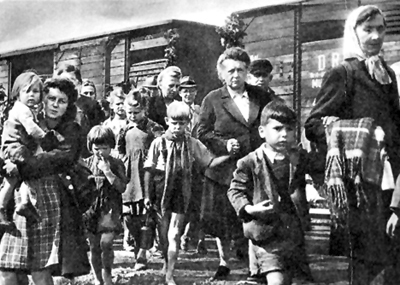 Expulsion of Germans from Czechoslovakia following the end of World War II During the Holocaust in World War II, Nazi Germany pursued a policy of ensuring that Europe was "cleaned of Jews" (judenrein).[23] The Nazi Generalplan Ost called for the genocide and ethnic cleansing of most Slavic people in central and eastern Europe for the purpose of providing more living space for the Germans.[24] During the Genocide of Serbs in the Independent State of Croatia, the euphemism čišćenje terena ("cleansing the terrain") was used by the Croatian Ustaše to describe military actions in which non-Croats were purposely systematically killed or otherwise uprooted from their homes.[25][26] The term was also used in the December 20, 1941 directive of Serbian Chetniks in reference to the genocidal massacres they committed against Bosniaks and Croats between 1941 and 1945.[27] The Russian phrase очистка границ (ochistka granits; lit. "cleansing of borders") was used in Soviet documents of the early 1930s to refer to the forced resettlement of Polish people from the 22-kilometre (14 mi) border zone in the Byelorussian and Ukrainian SSRs.[citation needed] This process of the population transfer in the Soviet Union was repeated on an even larger scale in 1939–1941, involving many other groups suspected of disloyalty.[28] In its complete form, the term appeared for the first time in the Romanian language (purificare etnică) in an address by Vice Prime Minister Mihai Antonescu to cabinet members in July 1941. After the beginning of the invasion by the Soviet Union,[clarification needed] he concluded: "I do not know when the Romanians will have such chance for ethnic cleansing."[29] In the 1980s, the Soviets used the term "etnicheskoye chishcheniye" which literally translates to "ethnic cleansing" to describe Azerbaijani efforts to drive Armenians away from Nagorno-Karabakh.[30][31][32] It was widely popularized by the Western media during the Bosnian War (1992–1995). In 1992, the German equivalent of ethnic cleansing (German: ethnische Säuberung, pronounced [ˈʔɛtnɪʃə ˈzɔɪ̯bəʁʊŋ] ⓘ) was named German Un-word of the Year by the Gesellschaft für deutsche Sprache due to its euphemistic, inappropriate nature.[33] |
語源 アルメニア人大虐殺時のタウルス峠の難民。ヤング・ターク三頭政治は、オスマン帝国のどの地域においてもアルメニア人の人口を5~10%以下に減らすことを目指し、その結果100万人のアルメニア人が殺害された[13]。 この言葉の起源は、古代の文献で使用されていたギリシャ語の andrapodismos(ἀνδραποδισμός、直訳すると「奴隷化」)である。 古代の文献では、例えば紀元前335年のアレクサンドロス大王によるテーベ征服に伴う残虐行為を説明するのに用いられた[14]。1609年から1614 年にかけてスペインで行われたモリスコ人追放は、一部の著者が考えるところによれば、近代西洋世界における国家による民族浄化の一例である[1 5] 「ジェノサイド」という用語を生み出したラファエル・レムキンは、アメリカ入植者によるネイティブ・アメリカンの追放をジェノサイドの歴史的実例であると 考えた[16]。歴史家のゲイリー・アンダーソンなど、他の人々はジェノサイドという言葉はアメリカ史のいかなる側面も正確に表現していないと主張し、代 わりに「民族浄化」という言葉がより適切であると示唆している[17]。チェルケス人虐殺は「ツィツェクン」としても知られており、 19世紀の産業革命期に国家が主導した最初の大規模な民族浄化運動として、さまざまな歴史家から認識されている[18][19]。1860年代にチェルケ ス人虐殺作戦を指揮したロシア帝国軍のニコライ・エフダキモフ将軍は、イスラム教徒のチェルケス人を「疫病神」として、彼らの故郷から追放すべき存在とみ なした。ロシアの目的は領土の併合であり、ロシア軍による強制的なチェルケス人の追放は、エフダキモフによって「ochishchenie(浄化)」と命 名された[20]。 1900年代初頭、この用語の地域的なバリエーションは、チェコ人(očista)、ポーランド人(czystki etniczne)、フランス人(épuration )やドイツ人(Säuberung)の間でも使われていた[21][ページ番号が必要] 。1913年のカーネギー財団の報告書は、バルカン戦争のすべての当事者の行動を非難し、民族集団に対して行われた残虐行為を説明するさまざまな新しい用 語を含んでいた[22]。  第二次世界大戦の終結後のチェコスロバキアからのドイツ人の追放 第二次世界大戦中のホロコースト中、ナチス・ドイツはヨーロッパからユダヤ人を「一掃」する政策を追求した 「ユダヤ人の浄化」(judenrein)であった[23]。ナチス・ドイツが策定した「総統東方計画」では、ドイツ人の生活空間を確保するために、中欧 および東欧のほとんどのスラブ民族に対する大量虐殺と民族浄化を行うことが求められていた[24]。クロアチア独立国におけるセルビア人虐殺では、ユー フォリズム的な表現である「čišćenje terena」(「地面の浄化」)が、 クロアチア人以外の住民が意図的に組織的に殺害されたり、家から追放されたりするような軍事行動について、クロアチア・ウスタシャが「地形浄化」という婉 曲表現を用いた[25][26]。この用語は、1941年から1945年にかけてボスニア人やクロアチア人に対して行った大量虐殺を指して、1941年 12月20日付のセルビア・チェトニクの指令でも使用された 5[27]。ロシア語の「очистка границ(ochistka granits、直訳すると「国境の浄化」)という表現は、1930年代初期のソビエトの文書で、ベラルーシとウクライナソビエト社会主義共和国の22キ ロメートルの国境地帯からのポーランド人の強制移住を指すために使用されていた[出典が必要]。ソビエト連邦におけるこの人口移動のプロセスは、1939 年から1941年にかけてさらに大規模な規模で繰り返され、多くの他の不忠誠が疑われる集団も巻き込まれた[28]。 この用語は、1941年7月にミハイ・アントネスク副首相が閣僚たちに行った演説の中で、ルーマニア語(purificare etnică)として初めて完全な形で登場した。ソビエト連邦による侵攻開始後、[注釈が必要]彼は次のように締めくくった。「ルーマニア人が民族浄化を 行う機会がいつ訪れるかはわからない」[29]。1980年代、ソビエト連邦は「民族浄化」を意味する「etnicheskoye chishcheniye」という用語を、 」という言葉を使って、アゼルバイジャンがアルメニア人をナゴルノ・カラバフから追い出す努力を評した[30][31][32]。これはボスニア戦争 (1992年~1995年)中に欧米のメディアによって広く普及した。 1992年、ドイツ語における民族浄化(ドイツ語: ethnische Säuberung、発音 [ˈʔɛtnɪʃə ˈzɔɪ̯bəʁʊŋ] ⓘ)は、その婉曲的で不適切な性質から、ドイツ語協会により「今年のドイツ語不適切語」に選ばれた[33]。 |
| Definitions The Final Report of the Commission of Experts established pursuant to Security Council Resolution 780 defined ethnic cleansing as: a purposeful policy designed by one ethnic or religious group to remove by violent and terror-inspiring means the civilian population of another ethnic or religious group from certain geographic areas", [noting that in the former Yugoslavia] " 'ethnic cleansing' has been carried out by means of murder, torture, arbitrary arrest and detention, extra-judicial executions, rape and sexual assaults, confinement of civilian population in ghetto areas, forcible removal, displacement and deportation of civilian population, deliberate military attacks or threats of attacks on civilians and civilian areas, and wanton destruction of property. Those practices constitute crimes against humanity and can be assimilated to specific war crimes. Furthermore, such acts could also fall within the meaning of the Genocide Convention.[34][35] The official United Nations definition of ethnic cleansing is "rendering an area ethnically homogeneous by using force or intimidation to remove from a given area persons of another ethnic or religious group."[36] As a category, ethnic cleansing encompasses a continuum or spectrum of policies. In the words of Andrew Bell-Fialkoff, "ethnic cleansing ... defies easy definition. At one end it is virtually indistinguishable from forced emigration and population exchange while at the other it merges with deportation and genocide. At the most general level, however, ethnic cleansing can be understood as the expulsion of a population from a given territory."[37] Terry Martin has defined ethnic cleansing as "the forcible removal of an ethnically defined population from a given territory" and as "occupying the central part of a continuum between genocide on one end and nonviolent pressured ethnic emigration on the other end."[28] Gregory Stanton, the founder of Genocide Watch, has criticised the rise of the term and its use for events that he feels should be called "genocide": because "ethnic cleansing" has no legal definition, its media use can detract attention from events that should be prosecuted as genocide.[17][38] As a crime under international law There is no international treaty that specifies a specific crime of ethnic cleansing;[39] however, ethnic cleansing in the broad sense—the forcible deportation of a population—is defined as a crime against humanity under the statutes of both the International Criminal Court (ICC) and the International Criminal Tribunal for the Former Yugoslavia (ICTY).[40] The gross human rights violations integral to stricter definitions of ethnic cleansing are treated as separate crimes falling under public international law of crimes against humanity and in certain circumstances genocide.[41] There are also situations, such as the expulsion of Germans after World War II, where ethnic cleansing has taken place without legal redress (see Preussische Treuhand v. Poland). Timothy v. Waters argues that similar ethnic cleansing could go unpunished in the future.[42] Mutual ethnic cleansing Mutual ethnic cleansing occurs when two groups commit ethnic cleansing against minority members of the other group within their own territories. For instance in the 1920s, Turkey expelled its Greek minority and Greece expelled its Turkish minority following the Greco-Turkish War.[43] Other examples where mutual ethnic cleansing occurred include the First Nagorno-Karabakh War[44] and the population transfers by the Soviets of Germans, Poles, and Ukrainians after World War II.[45] |
定義 安全保障理事会決議780に基づき設置された専門家委員会の最終報告書では、民族浄化は次のように定義されている。 「ある民族または宗教集団が、暴力や恐怖を煽動する手段を用いて、特定の地域から別の民族または宗教集団の民間人を排除することを目的とした政策」であ り、旧ユーゴスラビアでは、「 「民族浄化」は、殺人、拷問、恣意的な逮捕と拘留、超法規的処刑、強姦や性的暴行、ゲットー地区への一般市民の監禁、一般市民の強制移送、一般市民の強制 退去、一般市民や一般市民居住地域への意図的な軍事攻撃や攻撃の脅威、そして無差別な財産破壊によって行われてきた。これらの行為は人道に対する犯罪であ り、特定の戦争犯罪と同等と見なされる。さらに、このような行為はジェノサイド条約[34][35]の定義にも該当する可能性がある。 国連の公式定義によると、民族浄化とは「武力や脅迫を用いて、特定の地域から他の民族や宗教集団の人々を排除し、その地域を民族的に均質化すること」 [36]である。民族浄化というカテゴリーには、一連の政策やさまざまな政策が含まれる。アンドリュー・ベル・フィアルコフは、「民族浄化は...簡単に 定義できるものではない。一方では、強制移住や人口交換とほとんど区別がつかないが、他方では、国外追放や大量虐殺と結びついている」と述べている。もっ とも一般的なレベルでは、民族浄化は、ある地域から住民を追放することと理解できる」[37]。 テリー・マーティンは、民族浄化について「ある地域から民族的に定義された住民を強制的に追放すること」と定義し、また「一方では大量虐殺、他方では非暴力的圧力による民族移住という連続体の中心を占める」[28]と定義している。 ジェノサイド・ウォッチの創設者であるグレゴリー・スタントンは、民族浄化の高まりを批判している。用語と、彼が「ジェノサイド」と呼ぶべきだと感じる出 来事に対するその使用: 「民族浄化」に法的定義がないため、そのメディアでの使用は、ジェノサイドとして起訴されるべき出来事から人々の関心をそらしてしまう可能性がある [17][38]。 国際法上の犯罪として 民族浄化という特定の犯罪を明記した国際条約は存在しない[39]が、広義の民族浄化、すなわち集団の強制追放は、国際刑事裁判所(ICC)と旧ユーゴス ラビア国際戦犯法廷(ICTY)の両方の規約において、人道に対する犯罪として定義されている 国際刑事裁判所(ICC)と旧ユーゴスラビア国際戦犯法廷(ICTY)の両方によるものである[40]。民族浄化という厳密な定義に不可欠な重大な人権侵 害は、国際人道法に違反する犯罪、および特定の状況下ではジェノサイドとして、別の犯罪として扱われる[41]。第二次世界大戦後のドイツ人の追放など、 法的救済措置なしに民族浄化が行われた状況もある(Preussische Treuhand v. Polandを参照)。ティモシー・V・ウォーターズは、将来、同様の民族浄化行為が罰せられないままになる可能性があると主張している[42]。 相互民族浄化 相互民族浄化とは、2つのグループが自国の領土内で、他方のグループの少数民族に対して民族浄化行為を行うことである。例えば、1920年代にトルコはギ リシャ・トルコ戦争の後、トルコ国内のギリシャ系少数派を国外追放し、ギリシャもトルコ国内のトルコ系少数派を追放した[43]。相互民族浄化が行われた 他の例としては、第一次ナゴルノ・カラバフ戦争[44]や、第二次世界大戦後にソビエト連邦がドイツ人、ポーランド人、ウクライナ人に対して行った人口移 動[45]などがある。 |
Causes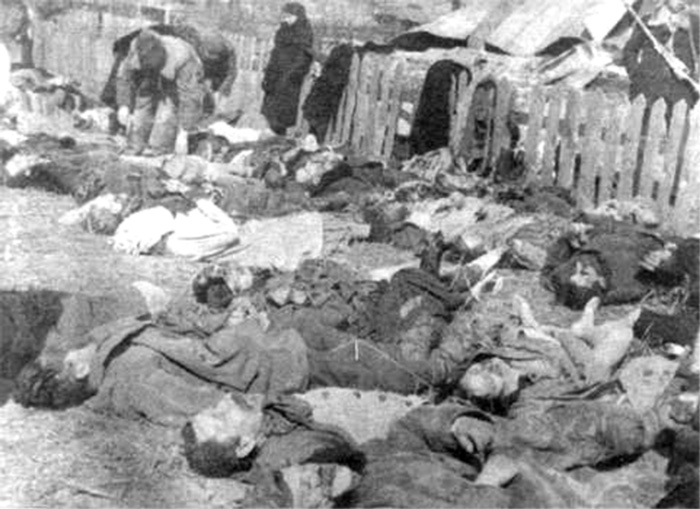 Massacres of Poles in Volhynia in 1943. Most Poles of Volhynia had either been murdered or had fled the area. This section relies largely or entirely on a single source. Relevant discussion may be found on the talk page. Please help improve this article by introducing citations to additional sources. Find sources: "Ethnic cleansing" – news · newspapers · books · scholar · JSTOR (March 2024) According to Michael Mann, in The Dark Side of Democracy (2004), murderous ethnic cleansing is strongly related to the creation of democracies. He argues that murderous ethnic cleansing is due to the rise of nationalism, which associates citizenship with a specific ethnic group. Democracy, therefore, is tied to ethnic and national forms of exclusion. Nevertheless, it is not democratic states that are more prone to commit ethnic cleansing, because minorities tend to have constitutional guarantees. Neither are stable authoritarian regimes (except the nazi and communist regimes) which are likely perpetrators of murderous ethnic cleansing, but those regimes that are in process of democratization. Ethnic hostility appears where ethnicity overshadows social classes as the primordial system of social stratification. Usually, in deeply divided societies, categories such as class and ethnicity are deeply intertwined, and when an ethnic group is seen as oppressor or exploitative of the other, serious ethnic conflict can develop. Michael Mann holds that when two ethnic groups claim sovereignty over the same territory and can feel threatened, their differences can lead to severe grievances and danger of ethnic cleansing. The perpetration of murderous ethnic cleansing tends to occur in unstable geopolitical environments and in contexts of war. As ethnic cleansing requires high levels of organisation and is usually directed by states or other authoritative powers, perpetrators are usually state powers or institutions with some coherence and capacity, not failed states as it is generally perceived. The perpetrator powers tend to get support by core constituencies that favour combinations of nationalism, statism, and violence.[46] Ethnic cleansing was prevalent during the Age of Nationalism in Europe (19th and 20th centuries).[47][48] Multi-ethnic European engaged in ethnic cleansing against minorities in order to pre-empt their secession and the loss of territory.[47] Ethnic cleansing was particularly prevalent during periods of interstate war.[47] |
原因 1943年のヴォルィーニにおけるポーランド人の虐殺。ヴォルィーニのポーランド人の大半は殺害されたか、その地域から逃亡した。 このセクションは、主に、あるいは完全に単一の情報源に依存している。関連する議論はトークページで見つけることができる。追加の情報源を引用することで、この記事の改善にご協力ください。 情報源を探す: 「民族浄化」 – ニュース · 新聞 · 書籍 · 学術 · JSTOR (2024年3月) マイケル・マンは『民主主義の闇』(2004年)の中で、殺戮を伴う民族浄化は民主主義の成立と密接な関係があると主張している。 彼は、殺戮を伴う民族浄化は、特定の民族集団と市民権を結びつけるナショナリズムの高まりに起因すると論じている。 したがって、民主主義は民族や国家による排除と結びついている。 とはいえ、少数民族には憲法上の保障がある傾向があるため、民族浄化を行う傾向が強いのは民主国家ではない。また、ナチスや共産主義体制のような安定した 権威主義体制も、民族浄化行為の加害者となる可能性は低い。民族浄化行為の加害者となる可能性が高いのは、民主化過程にある体制である。民族間の敵対は、 社会階層の原初的なシステムとして民族性が社会階級を圧倒する場合に現れる。通常、社会が深く分裂している社会では、階級や民族といったカテゴリーが深く 絡み合っている。ある民族集団が他者を抑圧したり搾取していると見なされた場合、深刻な民族紛争が発生する可能性がある。マイケル・マンは、2つの民族グ ループが同じ領土の主権を主張し、脅威を感じると、その違いが深刻な不満や民族浄化につながる可能性があると主張している。 殺戮を伴う民族浄化は、不安定な地政学的環境や戦争の文脈で発生しやすい。民族浄化には高度な組織化が必要であり、通常は国家やその他の権威ある権力に よって指示されるため、実行者は一般的に認識されているような破綻国家ではなく、ある程度のまとまりと能力を持つ国家権力や機関であることが多い。加害者 となる権力は、民族主義、国家主義、暴力の組み合わせを好む中核支持層から支持を得がちである[46]。 民族浄化は、ヨーロッパのナショナリズムの時代(19世紀と20世紀)に広まっていた[47][48]。多民族国家のヨーロッパでは、少数民族の分離や領 土の喪失を未然に防ぐために、少数民族に対する民族浄化が行われていた[47]。民族浄化は、国家間の戦争の時期に特に広まっていた[47]。 |
Genocide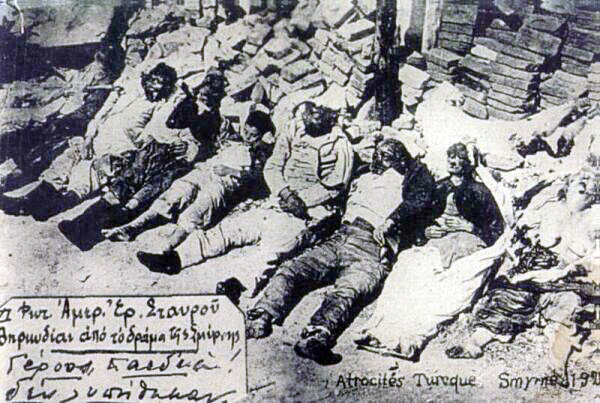 Photo taken after the burning of Smyrna. From 1914 until 1923, Ottoman Greeks in Thrace and Asia Minor were subject to a campaign including massacres and deportations. The International Association of Genocide Scholars (IAGS) recognizes it as genocide and refers to the campaign as the Greek Genocide.[49] Ethnic cleansing has been described as part of a continuum of violence whose most extreme form is genocide. Ethnic cleansing is similar to forced deportation or population transfer. While ethnic cleansing and genocide may share the same goal and methods (e.g., forced displacement), ethnic cleansing is intended to displace a persecuted population from a given territory, while genocide is intended to destroy a group.[50][51] Some academics consider genocide to be a subset of "murderous ethnic cleansing".[52] As Norman Naimark writes, these concepts are different but related, for "literally and figuratively, ethnic cleansing bleeds into genocide, as mass murder is committed in order to rid the land of a people."[53] William Schabas states "ethnic cleansing is also a warning sign of genocide to come. Genocide is the last resort of the frustrated ethnic cleanser."[50] Multiple genocide scholars have criticized distinguishing between ethnic cleansing and genocide, arguing that because both ultimately result in the destruction of a group, the use of the term "ethnic cleansing" is a form of genocide denial.[a][54][17][38] |
ジェノサイド スミルナの焼失後に撮影された写真。1914年から1923年にかけて、トラキアと小アジアのオスマン帝国領内のギリシャ系住民は、虐殺や強制移住を含む キャンペーンに苦しめられた。国際ジェノサイド学者協会(IAGS)はこれをジェノサイドと認定し、このキャンペーンをギリシャ人虐殺と呼んでいる [49]。 民族浄化は、ジェノサイドという最も極端な形態を含む暴力の一連の流れの一部であると説明されている。民族浄化は、強制送還や人口移動に類似している。民 族浄化と大量虐殺は、同じ目的と手段(強制移住など)を共有している可能性があるが、民族浄化は迫害された集団を特定の地域から追放することを目的として いるのに対し、大量虐殺は集団を破壊することを目的としている[50][51]。 一部の学者は、大量虐殺を「殺戮を伴う民族浄化」の一部とみなしている[5 2] ノーマン・ナイマークが書いているように、これらの概念は異なるが関連している。「文字通りにも比喩的にも、民族浄化は大量虐殺によって土地から人々を排 除するという意味で、ジェノサイドに発展する可能性がある」[53] ウィリアム・シャバスは、「民族浄化は、これから起こるジェノサイドの前兆でもある。ジェノサイドは、挫折した民族浄化主義者の最後の手段である」 [50]。複数のジェノサイド研究者は、民族浄化とジェノサイドを区別することについて批判しており、どちらも最終的には集団の破壊につながるため、「民 族浄化」という用語の使用はジェノサイド否定の一形態であると主張している[a][54][17][38]。 |
As a military, political, and economic tactic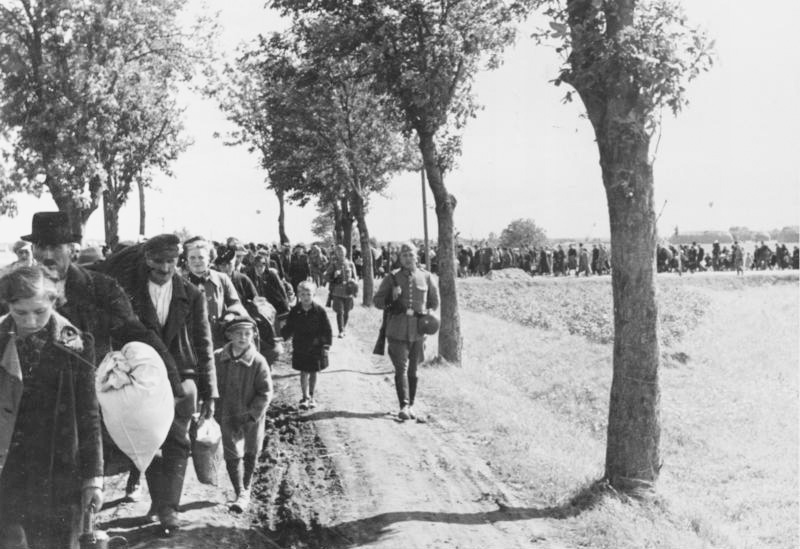 Expulsion of Poles by Nazi Germany. Poles are led to trains under German army escort, as part of the ethnic cleansing of western Poland annexed to the German Reich following the invasion. 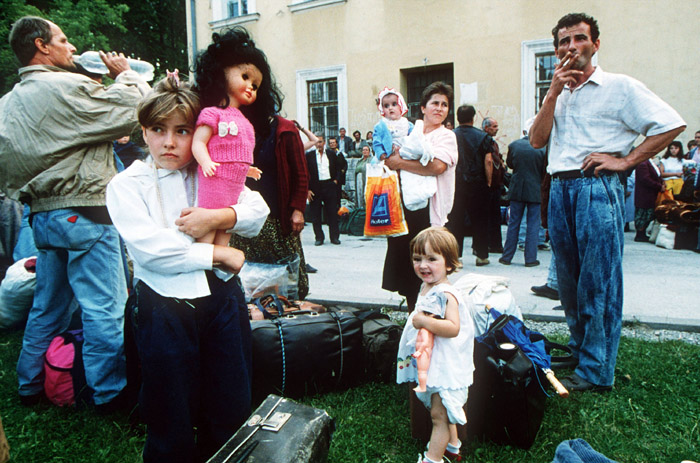 A group of Bosniaks from the Lašva Valley close by Travnik, Bosnia and Herzegovina that were forced out of their homes and villages by Croat forces in 1993  Exhumed victims of the Srebrenica massacre carried out by Serb forces, part of the ethnic cleansing in the Bosnian War 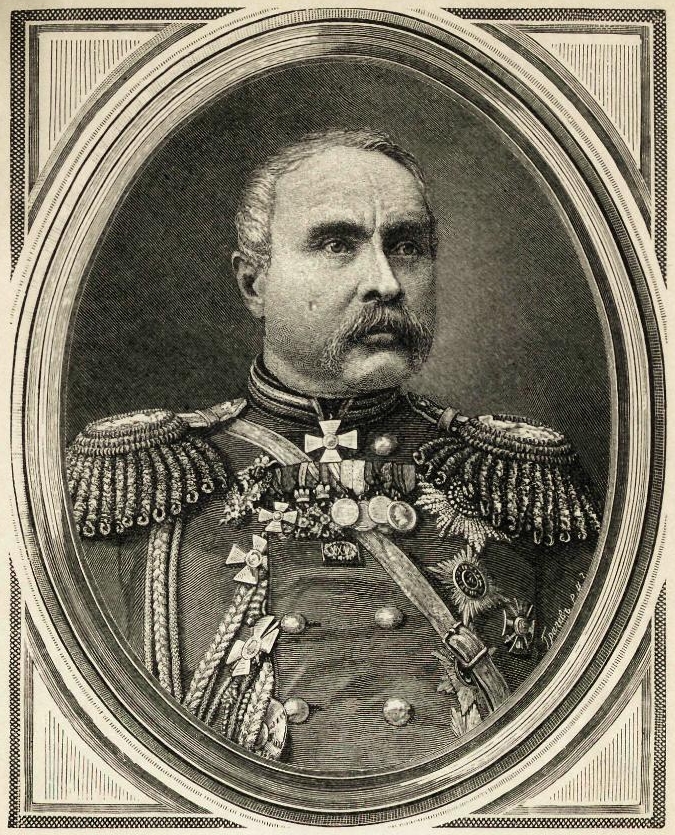 Russian Count Nikolay Yevdokimov, who organized the extermination campaigns of "Tsitsekun", designated Russian military operations targeting Circassian natives by the term “ochishchenie” (cleansing).[20][55] 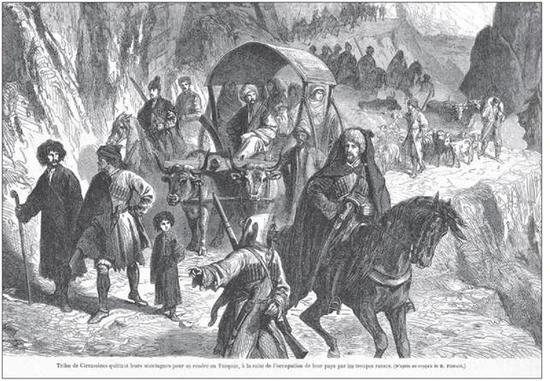 Portrait of Circassian refugees evicting their towns and villages after the Russian invasion of Circassia. According to some authors, Russian military forces massacred and forcibly deported between 95 and 97% of all native Circassians during the Circassian genocide.[56][57] The resettlement policy of the Neo-Assyrian Empire in the 9th and 7th centuries BC is considered by some scholars to be one of the first cases of ethnic cleansing.[58] During the 1980s, in Lebanon, ethnic cleansing was common during all phases of the conflict, notable incidents were seen in the early phase of the war, such as the Damour massacre, the Karantina massacre, the Siege of the Tel al-Zaatar Palestinian refugee camp, and during the 1982 Lebanon War such as the Sabra and Shatila Massacre committed by Lebanese Maronite forces backed by Israel against Palestinian refugees and Lebanese Shia civilians. After the Israeli withdrawal from the Chouf, the Mountain War broke out, where ethnic cleansings (mostly in the form of tit-for-tat killings) occurred. During, the Syrian backed, mostly Druze dominated People's Liberation Army used a policy they called "territorial cleansing" to "drain" the Chouf of Maronite Christians in order to deny them of resisting the advance of the PSP. As a result, 163,670 Christian villagers were displaced due to these operations. In response to these massacres, the Lebanese Forces conducted a similar policy, which resulted in 20,000 Druze displaced. Ethnic cleansing was a common phenomenon in the wars in Croatia, Kosovo, and Bosnia and Herzegovina. This entailed intimidation, forced expulsion, or killing of the unwanted ethnic group as well as the destruction of the places of worship, cemeteries and cultural and historical buildings of that ethnic group in order to alter the population composition of an area in the favour of another ethnic group which would become the majority. According to numerous ICTY verdicts and indictments, Serb[59][60][61] and Croat[62] forces performed ethnic cleansing of their territories planned by their political leadership to create ethnically pure states (Republika Srpska and Republic of Serbian Krajina by the Serbs; and Herzeg-Bosnia by the Croats). Survivors of the ethnic cleansing were left severely traumatized as a consequence of this campaign.[63] Israeli herders have engaged in a systemic displacement of Palestinian herders in Area C of the West Bank as a form of nationalist and economic warfare.[64][65][66] When enforced as part of a political settlement, as happened with the expulsion of Germans after World War II through the forced resettlement of ethnic Germans to Germany in its reduced borders after 1945, the forced population movements, constituting a type of ethnic cleansing, may contribute to long-term stability of a post-conflict nation.[67][page needed] Some justifications may be made as to why the targeted group will be moved in the conflict resolution stages, as in the case of the ethnic Germans, some individuals of the large German population in Czechoslovakia and prewar Poland had encouraged Nazi jingoism before World War II, but this was forcibly resolved.[67][page needed] According to historian Norman Naimark, during an ethnic cleansing process, there may be destruction of physical symbols of the victims including temples, books, monuments, graveyards, and street names: "Ethnic cleansing involves not only the forced deportation of entire nations but the eradication of the memory of their presence."[68] In many cases, the side perpetrating the alleged ethnic cleansing and its allies have fiercely disputed the charge.[clarification needed] |
軍事、政治、経済的な戦術として ナチス・ドイツによるポーランド人の追放。侵攻後、ドイツ帝国に併合された西ポーランドで行われた民族浄化の一環として、ポーランド人はドイツ軍に護衛された列車で追放された。  ボスニア・ヘルツェゴビナ、トラヴニク近郊のラシュヴァ渓谷に住むボスニア人(ボスニア・ヘルツェゴビナ)の一団。1993年にクロアチア軍によって家や村を追われた。  ボスニア戦争における民族浄化の一環としてセルビア軍によって行われたスレブレニツァ大虐殺の犠牲者。  ロシアのニコライ・ 「ツイツェクン」の絶滅作戦を組織したロシア人ニコライ・エヴドキモフ伯爵は、ロシア軍によるチェルケス人に対する作戦を「オチシェニエ」(浄化)と呼んだ[20][55]。  ロシアによるチェルケス侵攻後、町や村を追われたチェルケス人難民の肖像。一部の著述家によると、ロシア軍は、チェルケス人虐殺の際に、チェルケス人の95~97%を虐殺し、強制移住させたという。 紀元前9世紀から7世紀にかけての新アッシリア帝国の再定住政策は、一部の学者によって民族浄化の一例であると見なされている。 1980年代 1980年代、レバノンでは紛争のあらゆる局面で民族浄化が行われており、ダモール虐殺、カラティナ虐殺、テル・アル・ザータール難民キャンプ包囲戦など の初期の紛争段階や、イスラエルに支援されたレバノン・マロン派軍がパレスチナ難民やレバノン・シーア派市民に対して行ったサブラ・シャティーラ虐殺など の1982年のレバノン戦争の段階でも、顕著な事件が見られた。イスラエル軍がシュフから撤退した後、山岳戦争が勃発し、民族浄化(主に報復殺戮の形を とった)が発生した。その間、シリアが支援し、主にドルーズ派が支配する人民解放軍は、PSP の進撃を阻止するために、マロン派キリスト教徒を「排除」する「領土浄化」政策を実施した。その結果、これらの作戦により、163,670人のキリスト教 徒の村人が避難を余儀なくされた。これらの虐殺を受けて、レバノン軍も同様の政策を実施し、その結果、20,000人のドルーズ教徒が避難を余儀なくされ た。 民族浄化は、クロアチア、コソボ、ボスニア・ヘルツェゴビナでの戦争で一般的に見られた現象である。これは、特定の民族集団を威嚇し、強制的に追放したり 殺害したりすること、また、その民族集団の礼拝所や墓地、文化・歴史的建造物を破壊することなどを通じて、その地域の人口構成を別の民族集団(多数派とな る民族集団)に有利なものに変えることを意味した。 ICTYの多数の判決および起訴状によると、セルビア人[59][60][61]およびクロアチア人[62]の軍隊は、民族的に純粋な国家(セルビア人に よるスルプスカ共和国およびセルビア人クライナ共和国、クロアチア人によるヘルツェゴビナ)を創設するという政治指導部の計画に従って、自国の領土で民族 浄化を行った。 民族浄化作戦の生存者は、この作戦の結果、深刻な心的外傷を負った[63]。 イスラエルの牧畜業者は、民族主義と経済戦争の一環として、ヨルダン川西岸地区C地区のパレスチナ人牧畜業者の組織的な追放に関与している[64][65][66]。 政治的な解決の一環として強制的に実施された場合、第二次世界大戦後にドイツ人が追放され、1945年以降に縮小された国境のドイツへの強制移住が行われ たように、強制的な人口移動は、一種の民族浄化であり、紛争後の国家の長期的な安定に寄与する可能性がある[67][ページ番号が必要]。紛争解決の段階 において、対象グループが移動される理由について、いくつかの正当化がなされる可能性がある。1945年以降、縮小された国境のドイツへの強制移住を通じ て、第二次世界大戦後のドイツ人の追放が行われたように、政治的な解決の一部として強制的に行われる人口移動は、ある種の民族浄化であり、紛争後の国家の 長期的な安定に寄与する可能性がある[67][ページ番号が必要]。民族浄化の対象となった集団が紛争解決の段階で移動させられる理由については、いくつ かの正当化がなされる可能性がある。 、チェコスロバキアや戦前のポーランドに住むドイツ人の一部は第二次世界大戦前にナチスの国粋主義を奨励していたが、これは強制的に解決された[67] [ページ番号が必要] 歴史家のノーマン・ナイマークによると、民族浄化プロセスでは、寺院、書籍、記念碑、墓地、通りの名前など、犠牲者の物理的な象徴の破壊が行われる可能性 がある。「民族浄化は、国家全体の強制送還だけでなく、彼らの存在の記憶の抹殺をも伴う」[68]。多くの場合、民族浄化を行ったとされる側と、その同盟 国は、その容疑を強く争っている[注釈が必要]。 |
| List of ethnic cleansing campaigns |
|
| Main article: Outline of genocide studies Cultural genocide Discrimination based on skin tone Ethnic conflict Ethnic violence Ethnocentrism Ethnocide Forced displacement Identity cleansing Identity politics Nativism (politics) Political cleansing of population Population cleansing Racial segregation Racism Redlining Religious persecution Religious discrimination Religious segregation Religious violence Sectarian violence Social cleansing Sundown town Supremacism Xenophobia |
主な記事:ジェノサイド研究の概要 文化的ジェノサイド 肌の色に基づく差別 民族紛争 民族暴力 民族中心主義 民族虐殺 強制移住 アイデンティティの浄化 アイデンティティ政治 ナティヴィズム(政治) 政治による民族浄化 人口浄化 人種的隔離 人種差別 レッドライニング 宗教的迫害 宗教的差別 宗教的隔離 宗教的暴力 宗派間の暴力 社会的浄化 サンダウン・タウン 優越主義 外国人嫌悪 |
| Armenian genocide and the Holocaust Autogenocide Classicide Colonialism and genocide Command responsibility Cultural genocide Culture of violence theory Cumulative radicalization Death march Death squad Democide Denial of atrocities against indigenous peoples Effects of genocide on youth Eliticide Ethnic cleansing Ethnocide Eugenics Extermination camp Extermination through labour Femicide Forced assimilation Gendercide Genocidal massacre Genocidal intent Genocidal rape Genocide definitions Genocide denial Genocide education Genocide justification Genocide of indigenous peoples Genocide prevention Genocide recognition politics Genocides in history Incitement to genocide Mass killing Perpetrator studies Perpetrators, victims, and bystanders Rescuer (genocide) Pogrom Policide Political cleansing of population Politicide Population cleansing Population transfer Psychology of genocide Topocide Utilitarian genocide War and genocide War crime |
アルメニア人大虐殺とホロコースト 自虐的ジェノサイド クラスジェノサイド 植民地主義とジェノサイド 指揮責任 文化的ジェノサイド 暴力文化理論 累積的過激化 死の行進 死の部隊 デモサイド 先住民に対する残虐行為の否定 若者に対するジェノサイドの影響 エリートジェノサイド 民族浄化 民族虐殺 優生学 絶滅収容所 労働による絶滅 女性殺害 強制同化 ジェンダーサイド ジェノサイド的虐殺 ジェノサイド的意図 ジェノサイド的強姦 集団虐殺 集団虐殺の定義 集団虐殺の否定 集団虐殺教育 集団虐殺の正当化 集団虐殺のレイプ 先住民族の集団虐殺 集団虐殺の防止 集団虐殺の認識政治 歴史上の集団虐殺 集団虐殺への扇動 大量虐殺 加害者研究 加害者、被害者、傍観者 集団虐殺の救助者 ポグロム ポリサイド 政治的集団浄化 ポリサイド 人口浄化 人口移動 集団虐殺の心理学 トポサイド 功利主義的集団虐殺 戦争と集団虐殺 戦争犯罪 |
| https://en.wikipedia.org/wiki/Ethnic_cleansing |
リ ンク
文 献
そ の他の情報
Copyleft,
CC, Mitzub'ixi Quq Chi'j, 1996-2099